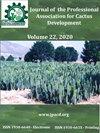仙人掌在不同蒸煮时间的理化变化评价
IF 0.4
4区 农林科学
Q4 HORTICULTURE
Journal of the Professional Association for Cactus Development
Pub Date : 2022-10-13
DOI:10.56890/jpacd.v24i.436
引用次数: 0
摘要
目的是评估和示意性地表征不同时间蒸汽烹饪引起的仙人掌(Opuntia ficus indica)的理化变化。将包层切成块(25 x 30 x 15 mm)并混合以获得四个样品,每个样品1250 g,并随机分配到每个处理:T1或对照;T2,烹饪4分钟;T3,持续7分钟;和T4,持续10分钟。烹饪后,将样品脱水,然后进行近端化学分析。通过固定效应模型对数据进行分析,并通过最小二乘法获得处理之间的差异。进行了化学成分的相关性分析。T2、T3和T4的蛋白质(?16.0/100 g DM)、脂质(?1.3 g/100 g DM)和无氮提取物(?20.2 g/100 g DM)的值高于T1;而膳食纤维(?33.6 g/100 g DM)和不溶性纤维(?22.0 g/100 g DM)均低于T1。可溶性纤维在T3和T4下降(分别为5.9和5.5 g/100 g DM),但在T2增加(14.5 g/100 g DM)。在这项研究中,100°C下的蒸汽烹饪改变了番荔枝的化学成分,这表明烹饪4分钟可能有助于保存枝节成分。本文章由计算机程序翻译,如有差异,请以英文原文为准。
Evaluation of physicochemical changes of Nopal (Opuntia ficus-indica) at different steam cooking times
The objective was to evaluate and schematically characterize the physicochemical changes of nopal (Opuntia ficus-indica) due to steam cooking at different times. Cladodes were cut into pieces (25 x 30 x 15 mm) and mixed to obtain four samples of 1250 g each on a fresh basis and randomly assigned to each treatment: T1 or Control; T2, cooking for 4 min; T3, for 7 min; and T4, for 10 min. After cooking, samples were dehydrated, and then a proximal chemical analysis was performed. The data were analyzed through a fixed-effect model, and the differences between treatments were obtained by least-squares means. Correlation analysis of chemical components was conducted. T2, T3, and T4 showed higher values of protein (?16.0/ 100 g DM), lipids (?1.3 g/100 g DM), and nitrogen-free extract (?20.2 g/100 g DM) than T1; whereas dietary fiber (? 33.6 g/100 g DM) and insoluble fiber (? 22.0 g/100 g DM) in these were lower than T1. Soluble fiber decreased in T3 and T4 (5.9 and 5.5 g/100 g DM, respectively) but increased in T2 (14.5 g/100 g DM). In this study, steam cooking at 100 °C modified the chemical composition of nopal (O. ficus-indica) suggesting that cooking for 4 min might help to preserve cladode components.
求助全文
通过发布文献求助,成功后即可免费获取论文全文。
去求助
来源期刊

Journal of the Professional Association for Cactus Development
Agricultural and Biological Sciences-Plant Science
CiteScore
1.10
自引率
33.30%
发文量
10
期刊介绍:
The editors of the Journal of the Professional Association for Cactus Development, are very excited to be a part of the excellent editorial committee and to work together to create the synergism between scientists, growers, legislators, and business people so vital to the development of this industry to serve the people of arid lands.
 求助内容:
求助内容: 应助结果提醒方式:
应助结果提醒方式:


